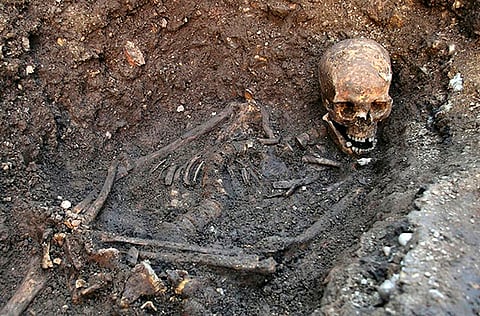Affair may have broken British royal bloodline, DNA test shows
Genetic sample from Richard III’s bones questions monarchs’ right to the throne

London: When the skeleton of Richard III was discovered in a car park in Leicester in 2012, archaeologists knew it was a momentous find. But little did they realise that it might expose other skeletons — those in the cupboard of the British aristocracy, and even call into question the blood line of the Royal family.
In order to prove the bones really were Richard III’s, scientists needed to take a DNA sample and match it to his descendants.
Genetic testing through his maternal DNA proved conclusively that the body was the king’s. However, when they checked the male line they discovered something odd. The DNA did not match, meaning that at some point in history an adulterous affair had broken the paternal chain.
Although it is impossible to say when the affair happened, if it occurred around the time of Edward III (1312- 1377) it could call into question whether kings such as Henry VI, Henry VII and Henry VIII had royal blood, and, therefore, the right to rule.
Without his claim to royalty, Henry VII is unlikely to have been able to raise an army for the Battle of Bosworth, in which Richard III was killed, and the history of England could have been very different. And it has implications for our current Royal family who share a direct blood line to the Tudors.
Kevin Schurer, professor of English local history, at the University of Leicester, said: “The first thing we need to get out of the way is that we are not indicating that Her Majesty should not be on the throne. “There are 19 links where the chain could have been broken so it is statistically more probable that it happened at a time where it didn’t matter. However, there are parts of the chain which, if broken, could hypothetically affect royalty.”
Because Richard III was childless, scientists looked at the descendants of Edward III, his great-great-grandfather. Fathers pass on a copy of their Y chromosome to their sons, so Richard and Edward should carry the same DNA. Likewise, any descendant of Edward’s would share the same Y chromosome as Richard, and a match would prove his royal descent.
Scientists were intrigued to find that the DNA did not match, suggesting that a “non-paternity event” occurred somewhere between Edward III and his descendants. In other words, someone was unknowingly illegitimate. If the illegitimate baby was Edward’s son John of Gaunt (1340-1399) or his son Henry IV (1366-1413) then the royal blood line would be lost.
Prof Schurer added: “If there is one particular link that has more significance than any other it has to be the link between Edward III and his son John of Gaunt. “John of Gaunt was the father of Henry IV, so if John of Gaunt was not actually the child of Edward III, arguably Henry IV had no legitimate right to the throne and, therefore, neither did Henry V, Henry VI and, indirectly, the Tudors. “Likewise, if the break is in the part of Richard III this would also ask questions about legitimacy of the claims of Richard and his brother Edward. However, you are never going to get an answer without exhuming a dead person.”
Henry VII (1457-1509) claimed a right to the throne through his wife Elizabeth of York, who was the daughter of Edward IV (1422-1483). Her royal line also came through John of Gaunt. Henry also had a royal blood line through Margaret Beaufort, his mother, who was the great-great-great-great-granddaughter of Edward I (1239-1307), but the Beauforts were banned by statute from ruling by Henry IV. Elizabeth Norton, a Tudor historian and author, said that the research could have wide implications for British history. “This is a very interesting finding. There are huge arguments about whether Elizabeth of York was legitimate,” she said. “This might suggest she did not have a royal blood line and, if so, then the Tudors did not either.”
She believes that the break is unlikely to have happened with John of Gaunt. “John of Gaunt and his wife are really a love story,” she said. “He married her and legitimised the children he had with her. So it’s unlikely that the link was broken there.”
The DNA results also revealed new details about the appearance of Richard III. It proves he is likely to have had blue eyes and blond hair, which may have darkened over time. Experts say a portrait of Richard which hangs in the Society of Antiquities in London is the closest representation of the former king. Dr Turi King, of the department of genetics at the University of Leicester, added: “There are no contemporary portraits of Richard — they all post-date his death by about 25 to 30 years onwards. So what I was interested in doing was looking at what the DNA evidence could tell us about what his hair and eye colour was predicted to be and see which portrait that most closely matches. “The DNA evidence indicates he has a high probability of having blue eye colour and blond hair. That would be a childhood hair colour, and hair can darken with age.”
Dr King is attempting to sequence the entire genome of Richard III to look for diseases and health issues that the king might have suffered. The Royal Household said it did not wish to comment on the research, which is published in the journal Nature Communications.
— The Daily Telegraph
Sign up for the Daily Briefing
Get the latest news and updates straight to your inbox


